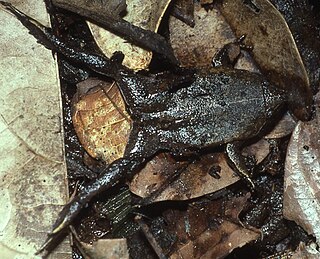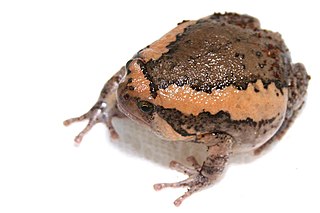
The Microhylidae, commonly known as narrow-mouthed frogs, are a geographically widespread family of frogs. The 683 species are in 63 genera and 11 subfamilies, which is the largest number of genera of any frog family.

Cophylinae is a subfamily of microhylid frogs endemic to Madagascar. It has over 100 species in eight genera. Members of this subfamily range from minute to fairly large, and they are highly ecologically diverse. DNA barcode research has revealed a significant taxonomic gap in this subfamily, and an estimated 70+ candidate species were identified. Many of these have subsequently been described, as well as numerous new discoveries.

Plethodontohyla is a genus of microhylid frogs endemic to Madagascar.

Stumpffia is a genus of microhylid frogs that are endemic to Madagascar. They are mostly brown frogs that typically live among leaf litter. S. contumelia has a snout–vent length length of about 8–9 mm (0.31–0.35 in), making it one of the world's smallest frogs, and several others in the genus are only slightly larger. The largest species is no more than 28 mm (1.1 in).

The Microhylinae are a subfamily of microhylid frogs. It contains 9 genera. Phylogenetic studies have estimated the family Microhylidae to be about 52 million years old.

Austrochaperina is a genus of microhylid frogs found on New Guinea, New Britain and Australia.
Copiula is a genus of microhylid frogs endemic to New Guinea. The common name Mehely frogs has been coined for them. They are leaf-litter inhabitants.

Ctenophryne is a genus of microhylid frogs. They occur in southern Central America and South America. Their common names are egg frogs and Nelson frogs, the latter applying to species in the formerly recognized Nelsonophryne.

Kaloula is a genus of microhylid frogs found in southern and eastern Asia. They are sometimes known as the Asian narrowmouth toads.

Microhyla, commonly known as the rice frogs or narrow-mouthed frogs, is a genus of frogs in the family Microhylidae. It consists of 42 species of diminutive frogs. Members of this genus are widespread from Ryukyu Is. in Japan, and throughout South-east Asia,.

Stereocyclops is a small genus of microhylid frogs. It is endemic to the Atlantic forest of eastern Brazil. Molecular phylogeny suggests that it is sister taxon to the clade containing Dasypops and Myersiella.

Uperodon taprobanicus, also known as the Sri Lankan bullfrog, Sri Lankan painted frog, Sri Lankan kaloula, Ceylon kaloula, Indian painted frog, or painted globular frog, is a species of narrow-mouthed frog found in Nepal, Bangladesh, southern and eastern India, and Sri Lanka up to an altitude of about 1300 metres. It can grow to an adult length of up to 75 millimetres(7.5 cm) long from snout to vent. It was originally described as a subspecies of Kaloula pulchra, ssp. taprobanica. The IUCN lists it as being of "Least Concern".
Hamptophryne alios is a species of frog in the family Microhylidae. It is known from three localities in the southwestern Amazon Basin of Bolivia, Brazil, and Peru. This species used to constitute the monotypic genus Altigius, but molecular phylogenetic analyses have shown it to be close relative of the then-monotypic Hamptophryne, and the two genera have been merged.

Hamptophryne is a small genus of microhylid frogs from South America. The genus was previously monotypic, but because of the close phylogenetic relationship between Hamptophryne and Altigius, another monotypic genus, the latter was placed in synonymy with Hamptophryne in 2012.

Stereocyclops histrio is a species of frog in the family Microhylidae. It is endemic to the northeastern Bahia state of Brazil where it occurs in remnants of the Atlantic forest. After the holotype was collected in 1944, the species went unrecorded until a population was found in the Una Biological Reserve and its surroundings in 1999. It is now known from four locations. Common name Bahia yellow frog has been coined for it, perhaps in reference to the bright lemon yellow coloration of the holotype. It was the only species in the genus Hyophryne until 2012 when molecular data demonstrated that it is nested within Stereocyclops species.

Elachistocleis pearsei is a species of frog in the family Microhylidae. It is found in the Caribbean drainage of Colombia and Panama and in northwest Venezuela.

Rhombophryne is a genus of microhylid frogs endemic to Madagascar. It is currently estimated to include more than 23 species, but only 20 of these are currently described. The common name 'diamond frog' has been proposed and used for members of this genus.

Brevicipitidae or rain frogs is a small family of frogs found in eastern and southern Africa. As of November 2013 contains 34 species in 5 genera. Formerly included as subfamily in Microhylidae, phylogenetic research has indicated the brevicipitine frogs should be considered as a family with Hemisotidae as the most closely related sister taxon.
Kaloula indochinensis is a species of frogs in the family Microhylidae. It is found in Indochina, in southern Vietnam, eastern Cambodia, and southern to central Laos. Prior to its being described, it was confused with Kaloula baleata.
Sphenophryne is a genus of frogs in the family Microhylidae from New Guinea. It reached its current composition in 2017 when Rivera and colleagues brought the genera Genyophryne, Liophryne, and Oxydactyla into synonymy of the then-monotypic Sphenophryne. However, the AmphibiaWeb continues to recognize these genera as valid.















